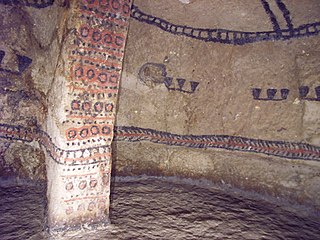Related Research Articles

A World Heritage Site is a landmark or area with legal protection by an international convention administered by the United Nations Educational, Scientific and Cultural Organization (UNESCO). World Heritage Sites are designated by UNESCO for having cultural, historical, scientific or other forms of significance. The sites are judged to contain "cultural and natural heritage around the world considered to be of outstanding value to humanity".
World Monuments Fund (WMF) is a private, international, non-profit organization dedicated to the preservation of historic architecture and cultural heritage sites around the world through fieldwork, advocacy, grantmaking, education, and training.

The Angono - Binangonan Petroglyphs are petroglyphs carved into a rock wall in Binangonan, Rizal, Philippines. It consists of 127 human and animal figures engraved on the rockwall probably carved during the late Neolithic, or before 2000 BC. They are the oldest known work of art in the Philippines. These inscriptions clearly show stylized human figures, frogs and lizards, along with other designs that may have depicted other interesting figures but erosion may have caused it to become indistinguishable. The engravings are mostly symbolic representations and are associated with healing and sympathetic magic.

The World Heritage Convention, formally the Convention Concerning the Protection of the World Cultural and Natural Heritage, is an international treaty signed on 23 November 1972, which created the World Heritage Sites, with the primary goals of nature conservation and the preservation of cultural properties. The convention, a signed document of international agreement, guides the work of the World Heritage Committee. It was developed over a seven-year period (1965–1972).
The Fire Mummies of the Philippines, also known as the Kabayan Mummies, Benguet Mummies, or Ibaloi Mummies, are a group of mummies found along the mountain slopes of Kabayan, a town in the northern part of the Philippines. They were made from as early as 2000 BCE. Today, they remain in natural caves and a museum in Kabayan.
An annual Heritage at Risk Register is published by Historic England. The survey is used by national and local government, a wide range of individuals and heritage groups to establish the extent of risk and to help assess priorities for action and funding decisions. This heritage-at-risk data is one of the UK government's official statistics.
The World Monuments Watch is a flagship advocacy program of the New York-based private non-profit organization World Monuments Fund (WMF) that calls international attention to cultural heritage around the world that is threatened by neglect, vandalism, conflict, or disaster.
The World Monuments Watch is a flagship advocacy program of the New York-based private non-profit organization World Monuments Fund (WMF) that is dedicated to preserving the historic, artistic, and architectural heritage around the world.
The World Monuments Watch is a flagship advocacy program of the New York-based private non-profit organization World Monuments Fund (WMF) that is dedicated to preserving the historic, artistic, and architectural heritage around the world.
The World Monuments Watch is a flagship advocacy program of the New York-based private non-profit organization, World Monuments Fund (WMF) that is dedicated to preserving and safeguarding the historic, artistic, and architectural heritage of humankind.
The World Monuments Watch is a flagship advocacy program of the New York-based private non-profit organization World Monuments Fund (WMF) and American Express to call upon every government in the world, preservation organizations, and other groups and individuals to nominate sites and monuments that are particularly endangered. At the same time, the nominators commit themselves to participate in a carefully planned preservation project.
The World Monuments Watch is a flagship advocacy program of the New York-based private non-profit organization World Monuments Fund (WMF) and American Express to call to action and challenge government authorities responsible for important cultural resources to identify sites immediately at risk, and to stimulate public awareness of the tremendous need to preserve and create sustainable uses for significant heritage made by man.
The World Monuments Watch is a flagship advocacy program of the New York-based private non-profit organization World Monuments Fund (WMF) and American Express aimed at identifying and preserving the world’s most important endangered cultural landmarks. It targets selected sites for immediate action, to call attention to the need for innovative approaches to protect threatened sites throughout the world.

The World Monuments Watch is a flagship advocacy program of the New York-based private non-profit organization World Monuments Fund (WMF) that calls international attention to cultural heritage around the world that is threatened by neglect, vandalism, conflict, or disaster.

The Spaç Prison was a political prison in Communist Albania at the village of Spaç. The former prison is listed as a second-category national monument. There were plans to turn the rapidly deteriorating site into a museum, but as of February 2013, no progress had been made at the location. In 1973, a number of prisoners staged a rebellion where the non-communist flag was raised. In 1984, a similar rebellion took place at the prison of Qafë Bar.

The World Monuments Watch is a flagship advocacy program of the New York-based private non-profit organization World Monuments Fund (WMF) that calls international attention to cultural heritage around the world that is threatened by neglect, vandalism, conflict, or disaster.
The World Monuments Watch is a flagship advocacy program of the New York-based private non-profit organization World Monuments Fund (WMF) that calls international attention to cultural heritage around the world that is threatened by neglect, vandalism, conflict, or disaster.
The World Monuments Watch is a flagship advocacy program of the New York-based private non-profit organization World Monuments Fund (WMF) that calls international attention to cultural heritage around the world that is threatened by neglect, vandalism, conflict, or disaster.
The World Monuments Watch is a flagship advocacy program of the New York-based private non-profit organization World Monuments Fund (WMF) that calls international attention to cultural heritage around the world that is threatened by neglect, vandalism, conflict, or disaster.
References
- ↑ Daniela Stigh (15 October 2015). "The 2016 World Monuments Watch Includes 50 At-Risk Cultural Heritage Sites in 36 Countries". World Monuments Fund. Retrieved 4 January 2016.